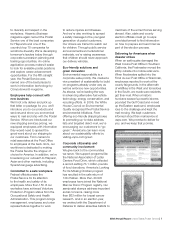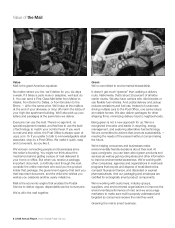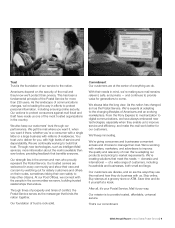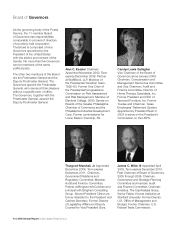US Postal Service 2008 Annual Report Download - page 17
Download and view the complete annual report
Please find page 17 of the 2008 US Postal Service annual report below. You can navigate through the pages in the report by either clicking on the pages listed below, or by using the keyword search tool below to find specific information within the annual report.
2008 Annual Report United States Postal Service | 17
only significant cost increase — cost-
of-living allowances for our bargaining
employees, which are linked to
inflation in the overall economy, were
the highest ever in 2008.
Postal employees did a yeoman’s
job rallying to the unprecedented
financial challenges, cutting costs
by $2 billion, and eliminating more
than 50 million work hours compared
to the prior year, even though the
delivery network grew by 1.2 million
new homes and businesses.
Employees made important progress
in transitioning to a new business
model established by the Postal
Accountability and Enhancement Act
(PAEA) and implementing long-term
strategic initiatives to further automate
mail processing and advance the
ongoing transformation of the Postal
Service. This performance is a credit
to the focus, discipline, and flexibility
of postal employees at all levels
to conserve resources, improve
business processes, and adjust
operations to respond to rapidly
changing demands.
Despite efforts that far exceeded
targets for both work-hour reductions
and cost savings, the Postal Service
finished the year with a $2.8 billion
loss. This includes $5.6 billion that we
paid into the Postal Service Retirees
Health Benefits Fund (PSRHBF), as
required by the new postal law.
Based on past experience, we
expect mail volumes to rebound
at least modestly when economic
conditions improve. Under current
economic conditions, however, there
remains significant risk of further
declines in mail volume. Therefore, in
view of the rapid, year-end business
deterioration experienced in FY
2008 and forecasts for continued
economic difficulty in 2009, we have
prepared ever more aggressive
strategies to lower costs, reduce
the size of our workforce, and to
adjust operations and resources. It
will be difficult for the Postal Service
to avoid further significant financial
losses under current circumstances if
present economic conditions persist
or worsen. Extraordinary cost-saving
efforts this year could not prevent
a $2.8 billion loss and inflationary
pressures will increase the challenge
in fiscal year 2009.
As we look to 2009, the Postal
Service is committed to doing its part
to keep mailing prices at or below
the rate of inflation and to fulfill its
legislative mandate to operate as a
business fully funded by the revenues
it earns and not by tax subsides. To
do so, the Postal Service must realize
every efficiency available, particularly
in realigning its infrastructure, and
matching resources and staffing
to demand. The support of all
stakeholders will be needed to make
these necessary changes.
In addition, it is time to reexamine
the accelerated 10-year payment
schedule mandated by the PAEA
for funding retiree health benefits.
The Postal Service continues to
support the sound business goal of
fully funding retiree health benefits.
However, the sizeable accelerated
yearly outlays required under the law
are growing increasingly untenable
in the current, unstable economic
environment. In the last 18 months,
we have contributed over $31 billion
into the PSRHBF, either through
direct payments or transfers from
other over-funded obligations.
The average annual payment of
$5.6 billion represents 7.5% of total
operating revenues, and it exceeds
the highest net income ever achieved
by the Postal Service. In the best
of times, the size of the payments
would present a considerable
financial challenge due to the rigorous
payment schedule. Under current
economic conditions — which were
not foreseen last year, let alone when
the PAEA was drafted and enacted —
the current funding schedule all but
guarantees that the Postal Service will
record continued financial losses for
the foreseeable future.
In congressional testimony last May,
Inspector General David Williams
suggested “indexing the payment to
Postal Service revenue or economic
factors, or extending the amortization
period.” Whatever mechanism may
be used, it is essential that we be
given the financial flexibility needed to
address the imminent challenges and
to preserve the health and viability
of the Postal Service, while also
fulfilling our long-range obligations.
It simply is not prudent to borrow
today to fund a future obligation while
incurring large financial losses. All of
our current debt is a direct result of
making these accelerated payments.
Postal employees can take pride
and confidence in their achievements
over the past year. Although we
face unusually tough economic
times, we also have faith in the
resilience of the American economy
and hope for improving conditions
worldwide. We look forward to
working with all stakeholders to
ensure our mutual success and the
quickest possible return to profitable
growth and success.
H. Glen Walker
Chief Financial Officer and
Executive Vice President
























